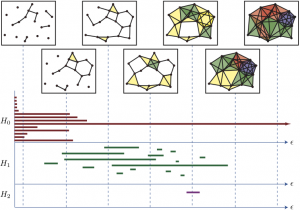Events in January 2020
-
PhD Seminars V
PhD Seminars V
–
January 13, 2020Talk 1
Siddarth Pritam (DataShape)
Title
Topological data analysis (A brief introduction)
Abstract
Topological Data Analysis (TDA) is a recent and fast growing field providing a set of new topological and geometric tools to infer relevant features (shape related) for possibly complex data. This talk will be a brief introduction, through a few selected topics (Topology, Simplicial complex, Persistent Homology... ), to basic fundamental and practical aspects of TDA for non experts.
Talk 2
Speaker
Title
Mutualised Development Actions - The Gnomon case
Abstract
The Gnomon project focuses on the acquisition, by a living organism such as a plant, of a shape in space over time. Experimental techniques over the last two decades suggest how the interactions of molecular actors within cells (such as genes) and the physical signals perceived by them contribute to the growth of this organism: aka - morphogenesis.
However, the exponentially growing size of this new data is a problem. The aim of this project is to extract a commensurable and relevant sub-set of data in order to qualify and predict morphogenesis.
This titanic mass of data contains geometric, biological and physical information. Also their treatment is a highly multidisciplinary activity.
The developed algorithms thus combine conceptual models, used to identify general principles of self-organization, with realistic numerical simulations, to test hypotheses.
In this context, experimental biologists systematically confront these algorithms with real quantitative data.
Based on a modular hybrid plug-in (cross language) architecture whose kernel and visualization layer are implemented in C ++ then wrapped in python allowing team members to specialize concepts algorithmic more or less abstract in python and dynamically. By embedding an interpreter and syntactic and semantic tools, Gnomon is a dynamic and autonomous integrated modeling and simulation platform.
This presentation will focus on the scientific, organizational and technical aspects of the development of this software platform by the center's experimentation and development department.
-
PhD Seminars VI
PhD Seminars VI
–
January 27, 2020Talk 1
Emre Baspinar (Mathneuro)
Title
An interplay of phenomenology, psychology and geometrical modeling in terms of visual perception
Abstract
Naturalizing phenomenology refers to putting the study of mind on con- crete foundations leading to a better understanding of the cognitive dimension of mind via the scientific methodology based on conjecture and refutation, trial and error. In a specific case of visual perception, a modeling task as a part of naturalizing phenomenology can be achieved starting from Husserlian phe- nomenology under the restriction of Gestalt psychology. We will see an intuitive explanation of such modeling approaches starting from their phenomenological and psychological principles by using the model of Citti and Sarti [1] as an example framework of perceptual models of vision.
References
[1] G. Citti and A. Sarti, A cortical based model of perceptual completion in the roto-translation space, Journal of Mathematical Imaging and Vision, 24, (3), pp. 307-326, 2006.Talk 2
Speaker
Title
Regularized building segmentation by frame field learning
Abstract
We add a frame field output to an image segmentation neural network to improve segmentation quality and provide additional geometric structure information for a subsequent polygonization step. A frame field allows to characterize two directions at every point of the image. We train a network to align the frame field to the tangent of ground truth contours. In addition to increasing the performance of the segmentation by leveraging the multi-task learning effect, our method produces a more regular segmentation and is more robust due to the additional learning signal.









